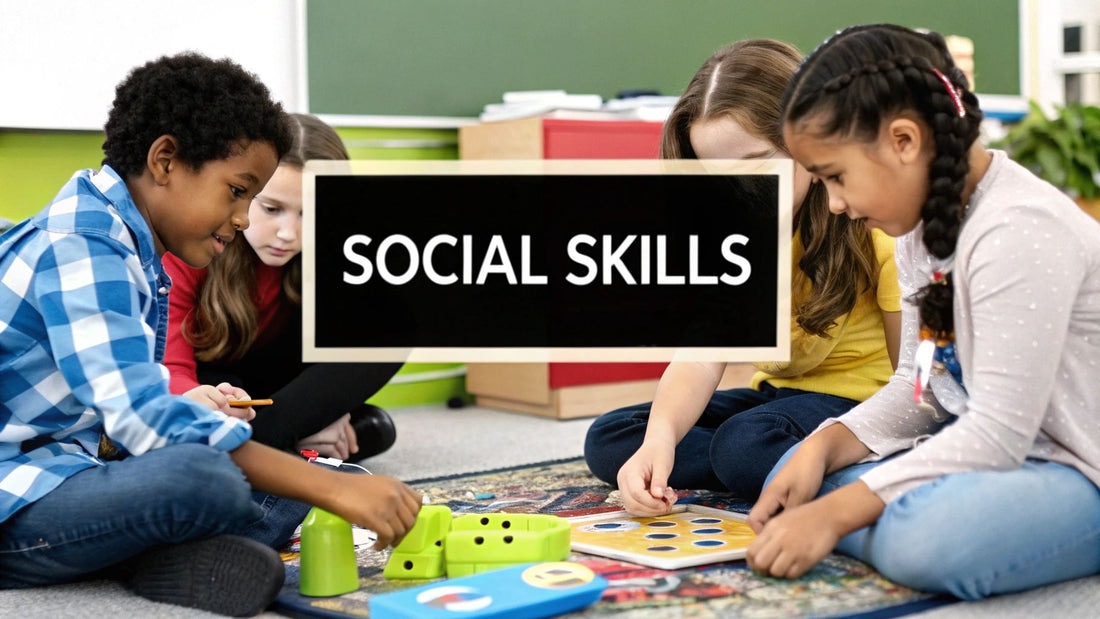
10 Effective Social Skills Activities for Kids in 2025
Share
In today's fast-paced, screen-focused environment, fostering strong social skills is more critical than ever for a child's mental wellbeing. These foundational abilities, including empathy, communication, and cooperation, are the building blocks of resilience and positive relationships, directly impacting long-term mental health. Statistics from the UK reveal a concerning increase in mental health challenges among young people, with one in six children aged 5-16 identified as having a probable mental health problem. This is often amplified by the pressures of social media, where curated online interactions can create unrealistic social expectations and affect self-esteem.
The consequences of underdeveloped social-emotional skills can be profound. They not only affect a child's immediate happiness and ability to form friendships but can also contribute to issues that persist into adulthood, impacting future career prospects and relationships. The cost to UK businesses from mental health-related issues is estimated at over £53 billion per year, highlighting the long-term economic importance of early intervention. This article is designed to provide parents, educators, and caregivers with a toolkit of practical and engaging social skills activities for kids. You will find a collection of easy-to-implement games and exercises aimed at developing crucial interpersonal abilities. By proactively nurturing these skills, we equip children to better navigate social complexities, manage their emotions effectively, and build a robust foundation for lifelong mental wellness, helping them thrive both now and in the future.
Disclaimer: I am not a mental health professional. The advice and activities in this article are for informational purposes only. If you have concerns about your child's mental health, please consult a qualified healthcare professional, such as your GP or a child psychologist. It is always best to seek professional help if you are worried.
1. Role-Playing and Dramatic Play
Role-playing is a powerful technique where children act out different social scenarios, stepping into various characters or real-life situations. This method provides a safe, controlled environment for them to practise interpersonal skills without real-world consequences. By engaging in dramatic play, children learn to see situations from different perspectives, which is fundamental for developing empathy and sophisticated problem-solving abilities. It's one of the most effective social skills activities for kids because it bridges imagination with practical application.
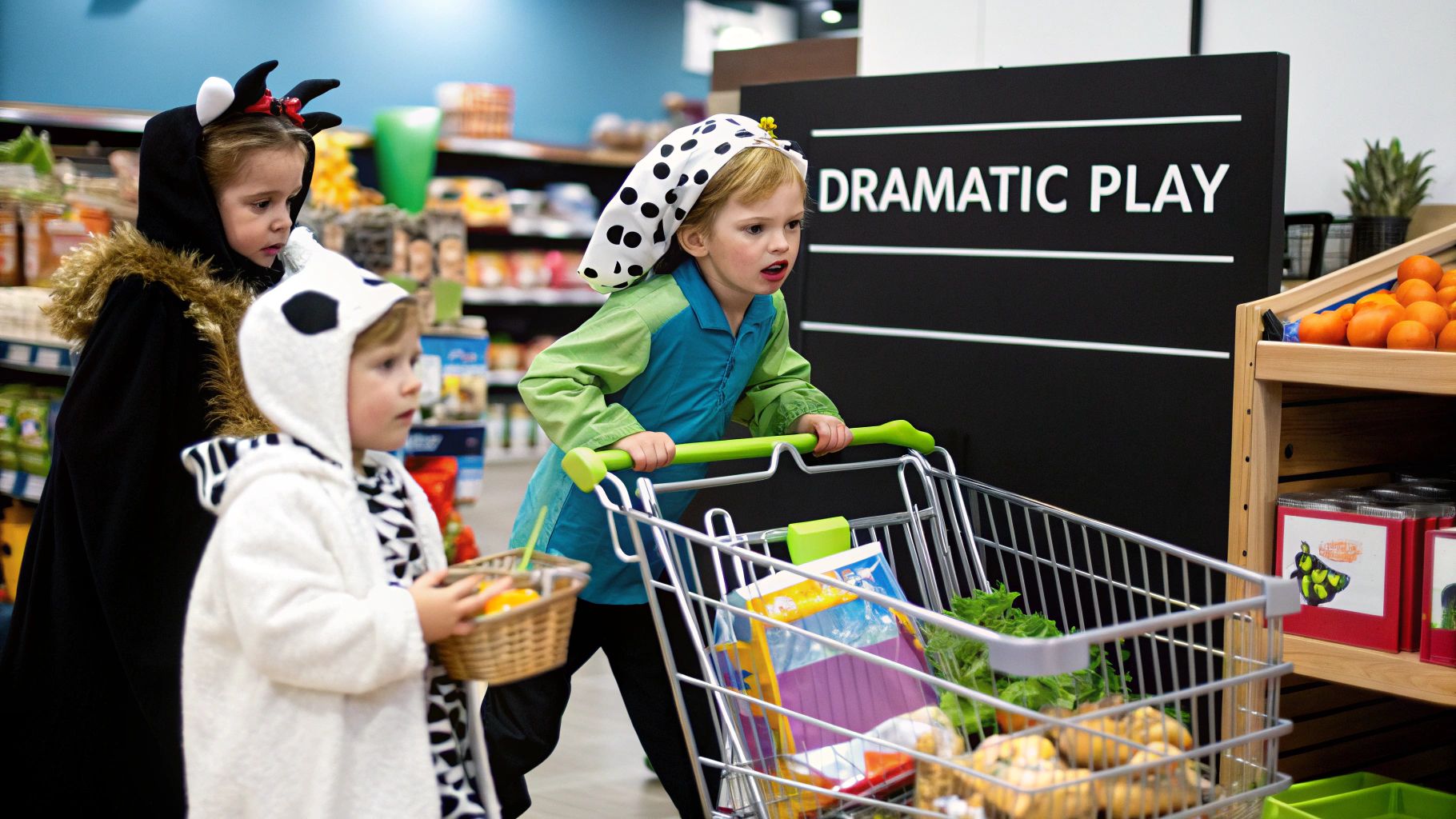
This approach, popularised by educators like Fred Rogers and methodologies like Social Thinking, helps children navigate complex social landscapes. For instance, a child can practise joining a game at the park, ordering a snack at a café, or resolving a disagreement with a friend over who gets the red crayon.
How to Implement Role-Playing
- Start Simple: Begin with familiar, low-stress scenarios like visiting the library or sharing a toy before moving on to more challenging situations like handling peer pressure. A practical example would be acting out how to ask another child if they can join in their game.
- Use Props: Costumes, puppets, and simple props make the experience more immersive and engaging, encouraging children to fully embrace their roles.
- Debrief Afterwards: After a scene, talk about what happened. Ask questions like, "How did that feel?" and "What could we try differently next time?"
- Rotate Roles: Ensure each child gets a chance to experience the scenario from multiple viewpoints. This reinforces empathy by helping them understand the feelings and motivations of others.
Key Insight: Role-playing is not about a perfect performance. The goal is to create a 'mistakes are okay' zone, where children feel safe to experiment with different responses and learn from the outcomes.
2. Cooperative Board Games and Team Challenges
Cooperative games require children to work together toward a common goal rather than competing against each other. These activities teach vital skills such as collaboration, communication, shared decision-making, and the value of teamwork. Unlike traditional competitive games, success depends on the entire group working in unison, making them one of the most effective social skills activities for kids by naturally promoting positive social interaction and reducing conflict.
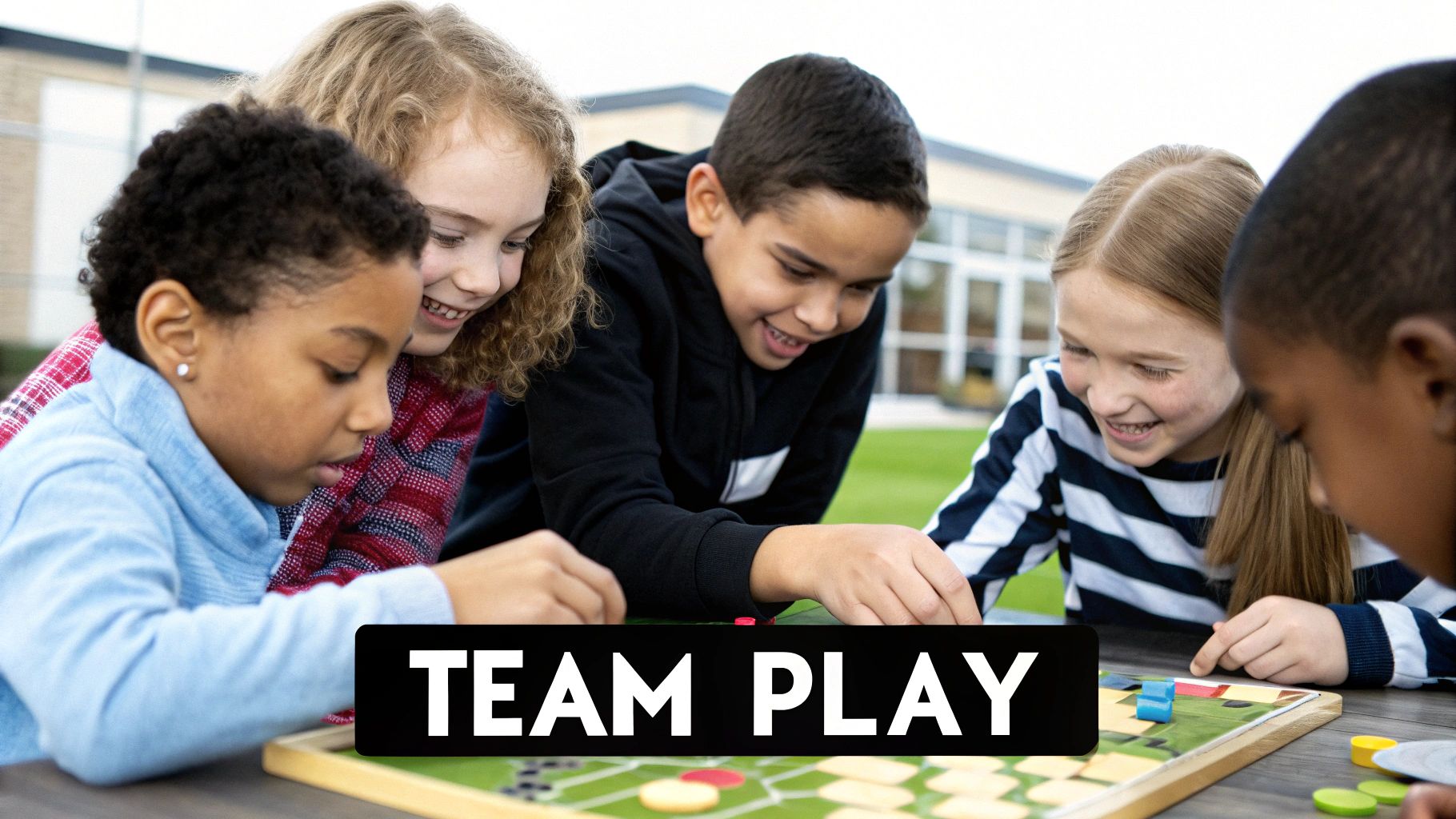
This approach has been championed by pioneers like Jim Deacove of Family Pastimes and popularised by companies like Peaceable Kingdom. Educational programmes such as Project Adventure also use team challenges to build resilience and social competence. For example, a game like 'Race to the Treasure' can teach a group of primary school children to plan a route together, while a challenge like building the tallest tower from spaghetti and marshmallows builds trust and communication among older youths. These activities are powerful tools for building a positive group dynamic.
How to Implement Cooperative Games
- Choose Wisely: Select games and challenges appropriate for the developmental level of all participants to ensure everyone can contribute meaningfully.
- Set Ground Rules: Before starting, establish clear expectations, such as 'everyone participates' and 'we listen to every idea', to foster an inclusive environment.
- Explain the 'Why': Encourage children to explain their reasoning when suggesting strategies. This builds critical thinking and helps others understand their perspective.
- Focus on Process: Celebrate the teamwork, communication, and effort involved, not just winning the game. This reinforces the value of collaboration.
Key Insight: Cooperative games shift the focus from 'me versus you' to 'us versus the problem'. This collaborative mindset is a foundational skill for healthy relationships, academic success, and future workplace environments.
You can learn more about team-building activities for children to find more ideas.
3. Emotion Charades and Feelings Identification Games
These activities help children recognise, label, and express emotions in themselves and others. Through engaging formats like charades, feeling faces matching, or emotion card games, children build their emotional vocabulary and practise reading vital non-verbal cues. This foundational skill, often called emotional literacy, is essential for developing empathy and communicating effectively. Addressing emotions early is crucial for mental health, as it provides children with the tools to understand and articulate their inner world.
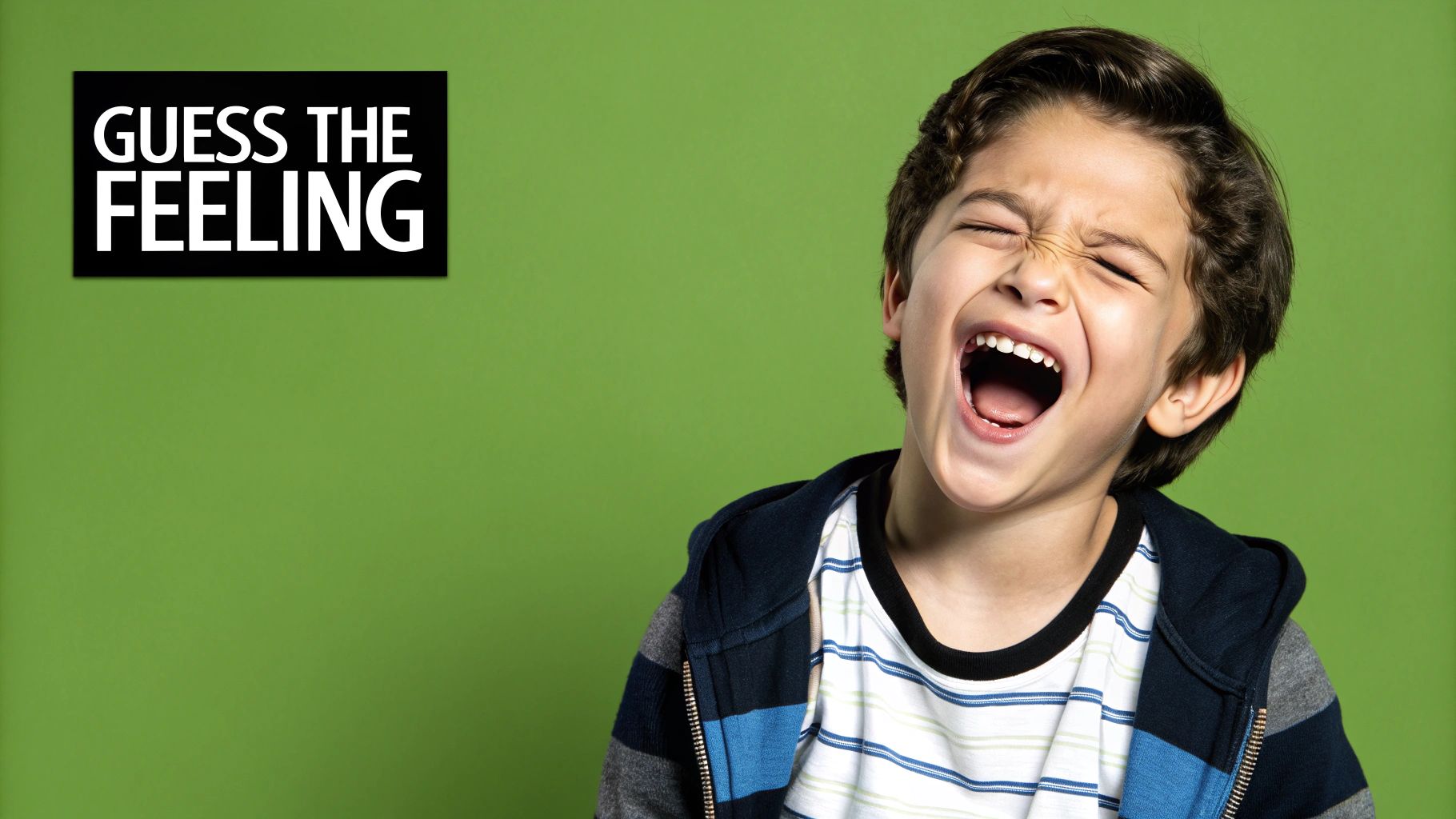
This approach is central to well-regarded social-emotional learning programmes like The Zones of Regulation and the RULER method from Yale University. For instance, a reception classroom might start the day with a 'feelings check-in' circle, or a therapist might use feeling cards in a social skills group for children with autism to explore different emotional states. For more ideas, you can explore various emotional intelligence games for kids.
How to Implement Feelings Identification Games
- Start Simple: Begin with basic emotions like happy, sad, angry, and scared before introducing more complex feelings like frustrated, proud, or lonely.
- Use a Mirror: Encourage children to look in a mirror as they make different facial expressions. This helps them connect the internal feeling to the external physical cues.
- Connect to Sensations: Help children link emotions to physical feelings in their bodies. Ask, "Where do you feel that in your body?" or say, "When I'm angry, my hands get tight."
- Read and Discuss: Use storybooks about emotions. Pause while reading to ask, "How do you think that character is feeling right now? How can you tell?" Books like "The Colour Monster" by Anna Llenas are excellent for this.
Key Insight: The goal is to validate all feelings as acceptable while teaching that not all behaviours are. This distinction empowers children to manage their emotions constructively, a key protective factor for their long-term mental health.
4. Turn-Taking and Conversation Circle Activities
Turn-taking and conversation circles are structured activities designed to teach children the fundamental rhythm of conversational exchange. In a safe, organised setting, children learn to wait for their turn to speak, listen actively to others, and contribute relevant thoughts. This method creates a predictable and equitable environment for dialogue, making it one of the most foundational social skills activities for kids, especially for those who struggle with impulsivity or conversational flow.
These practices are rooted in traditions like Indigenous talking circles and have been popularised by educational philosophies such as the Responsive Classroom approach. By using a physical object like a "talking stick" or a ball, the abstract concept of whose turn it is becomes concrete and easy for children to follow, reducing interruptions and fostering mutual respect.
How to Implement Conversation Circles
- Use a Talking Object: Introduce a special object (a decorated stick, a colourful ball, or a soft toy) that grants the holder the right to speak. This visual cue is clear and effective.
- Set Clear Expectations: Explain the rules: only the person holding the object may talk, everyone else practises active listening, and it's okay to 'pass' if you don't wish to share.
- Start with Simple Prompts: Begin with easy, non-threatening topics like, "What is your favourite animal?" or "What did you enjoy doing this weekend?" before moving to more complex discussions about feelings or ideas.
- Model Good Listening: As the facilitator, demonstrate what good listening looks like: maintain eye contact, nod, and ask gentle follow-up questions when appropriate. This shows children how to show genuine interest in what others are saying.
Key Insight: The primary goal is not just to talk, but to cultivate patient listening. Creating a space where every child's voice is valued builds confidence and teaches them that their perspective matters, which is vital for positive mental health and social development.
5. Social Stories and Comic Strip Conversations
Social Stories are short, personalised narratives that break down social situations into understandable steps, outlining what is happening, who is involved, and what the expected responses are. This structured approach, along with visual aids like Comic Strip Conversations, helps demystify social cues and interactions. These methods provide a concrete framework for understanding social expectations, making them some of the most effective social skills activities for kids, particularly those who benefit from visual and structured learning.
Developed by Carol Gray, this methodology is widely recognised for its success in supporting children with social communication difficulties, such as those on the autism spectrum. For instance, a special education teacher might create a Social Story to explain cafeteria behaviour, or a parent might use one to prepare their child for a doctor's visit, reducing anxiety and clarifying expectations.
How to Implement Social Stories
- Use a Specific Formula: A Social Story should include more descriptive sentences (what is happening) and perspective sentences (how others feel) than directive ones (what the child should do).
- Keep it Positive and Personal: Write from the child's perspective using "I will try to..." rather than "I must...". Incorporate photos or drawings of the child to make the story relatable and engaging.
- Introduce Before the Event: Read the story together multiple times in a calm setting before the social situation occurs. This repetition helps the child internalise the concepts and feel prepared.
- Utilise Comic Strips for Dialogue: Use simple stick figures and speech/thought bubbles to visually map out conversations. Assign different colours to represent various emotions, helping children connect words to feelings.
Key Insight: These tools are not about enforcing compliance; they are about fostering genuine understanding. The goal is to translate abstract social rules into a concrete, visual format that empowers the child with clarity and confidence.
6. Collaborative Art and Building Projects
Collaborative projects involve children working together to create a single artistic or construction piece, like a large mural, a complex LEGO structure, or a group collage. This process requires them to negotiate roles, share materials, compromise on creative ideas, and coordinate their efforts towards a unified goal. The hands-on, creative nature of these tasks makes practising social skills feel natural and engaging rather than forced, making them excellent social skills activities for kids.
Pioneered in educational philosophies like the Reggio Emilia approach and popularised in therapeutic settings by Dr Daniel LeGoff's LEGO-based therapy, this method turns creativity into a social lesson. Children learn the value of teamwork and see firsthand how collective effort can produce something greater than what they could achieve alone.
How to Implement Collaborative Projects
- Establish Group Norms: Before starting, set clear expectations such as, "Everyone gets to add an idea," and, "We respect each other's contributions."
- Assign Roles (If Needed): For groups struggling with organisation, assign specific roles like 'Materials Manager', 'Lead Designer', or 'Idea Recorder' to ensure everyone participates.
- Plan and Debrief: Begin with a planning phase where all ideas are heard and discussed. Afterwards, talk about the process, asking, "What worked well when we worked together?" and "What was challenging?"
- Celebrate the Outcome: Proudly display the final creation. This reinforces a sense of shared accomplishment and validates the collective effort, boosting self-esteem and group cohesion.
Key Insight: The finished product is secondary to the process. The main objective is for children to practise the complex social dance of communication, compromise, and shared creation in a low-stakes, supportive environment.
7. Peer Buddy Systems and Structured Play Dates
Peer buddy systems involve intentionally pairing children together for activities or play sessions. This approach offers a structured, low-pressure environment for children to practise social skills in a one-on-one setting, which is often less overwhelming than navigating large group dynamics. By providing a clear framework and initial adult support, these systems help build confidence, foster genuine friendships, and offer valuable social skills activities for kids who may find social situations challenging.
This method is effectively used in programmes like Best Buddies and Circle of Friends, which pair children with and without disabilities to promote inclusion and understanding. It allows children to develop reciprocal social skills, such as turn-taking and listening, in a manageable context before applying them to more complex social arenas.
How to Implement Peer Buddy Systems
- Match Wisely: Pair children based on shared interests or complementary temperaments. A more outgoing child might be a good match for a quieter one, creating a balanced dynamic.
- Provide Structure: Begin with a specific activity, like building a LEGO model or completing a craft project, rather than unstructured free play. This gives the interaction a clear focus.
- Set Expectations: Briefly talk to both children beforehand about the plan for the play date, such as what activity they will do and how long it will last.
- Gradually Reduce Support: Stay nearby to facilitate if needed, but allow the children space to interact independently. As their comfort and skills grow, you can reduce the structure and your involvement.
Key Insight: The aim is to create a positive foundation for friendship. Keep initial interactions short and sweet (e.g., 60-90 minutes) and consistent, allowing the relationship to develop naturally over time.
8. Group Sports and Physical Team Activities
Group sports and physical team activities are dynamic environments where children learn vital social skills through action. These organised games require teamwork, clear communication, and following rules to achieve a shared objective. This hands-on approach provides a natural setting for developing cooperation, leadership, and resilience, making it one of the most effective social skills activities for kids who learn best through movement.
This method, championed by organisations like the Positive Coaching Alliance and Playworks, teaches children how to handle both winning and losing gracefully. Participating in activities such as a local YMCA football team or a school's structured recess programme helps children build social confidence and understand the value of contributing to a team.
How to Implement Group Sports
- Prioritise Participation: Choose activities that emphasise effort and teamwork over just winning. Organisations like Girls on the Run combine physical activity with social-emotional learning, creating a supportive atmosphere.
- Rotate Roles: Ensure every child has the opportunity to try different positions and responsibilities. This helps them appreciate diverse contributions and develop leadership skills.
- Teach Good Sportsmanship: Explicitly discuss and model how to be a supportive teammate, a respectful opponent, and a graceful winner or loser.
- Modify Rules: Adapt games to ensure they are inclusive and safe for all skill levels and abilities. Using smaller teams can also increase individual participation and engagement.
Key Insight: The true value of team sports lies not in the final score, but in the social lessons learned along the way. Celebrate achievements in teamwork and perseverance as much as athletic accomplishments.
9. Problem-Solving and Conflict Resolution Scenarios
Teaching children how to navigate disagreements is a cornerstone of social development. Structured activities that present social dilemmas and conflicts allow them to practise critical thinking, negotiation, and compromise in a supportive setting. By working through hypothetical or real scenarios, children learn to identify problems, consider multiple perspectives, and collaboratively generate solutions. This makes it one of the most vital social skills activities for kids, equipping them with a framework for managing interpersonal challenges constructively.
This systematic approach is central to well-regarded social-emotional learning curricula like the Second Step programme and the Responsive Classroom methodology. The goal is to move children away from impulsive reactions towards thoughtful, empathetic responses when faced with conflict, a skill that is crucial for maintaining healthy relationships and positive mental wellbeing.
How to Implement Conflict Resolution Scenarios
- Introduce a Framework: Teach a consistent, simple problem-solving process. Using a visual aid, like the one below, can help children remember the steps: identify the problem, brainstorm solutions, and then choose and try one.
- Use Scenario Cards: For younger children, use picture cards or short written scenarios depicting common conflicts, such as two children wanting the same toy. This externalises the problem and reduces personal defensiveness.
- Start with Low Stakes: Practise with simple, non-personal problems first. For instance, figure out how to fairly share a limited resource in a game before tackling a real, emotionally charged friendship issue.
- Focus on Brainstorming: Encourage children to generate as many solutions as possible without immediate judgement. This fosters creative thinking and shows them there is often more than one "right" way to solve a problem.
The following infographic illustrates a clear, three-step process for guiding children through conflict resolution.
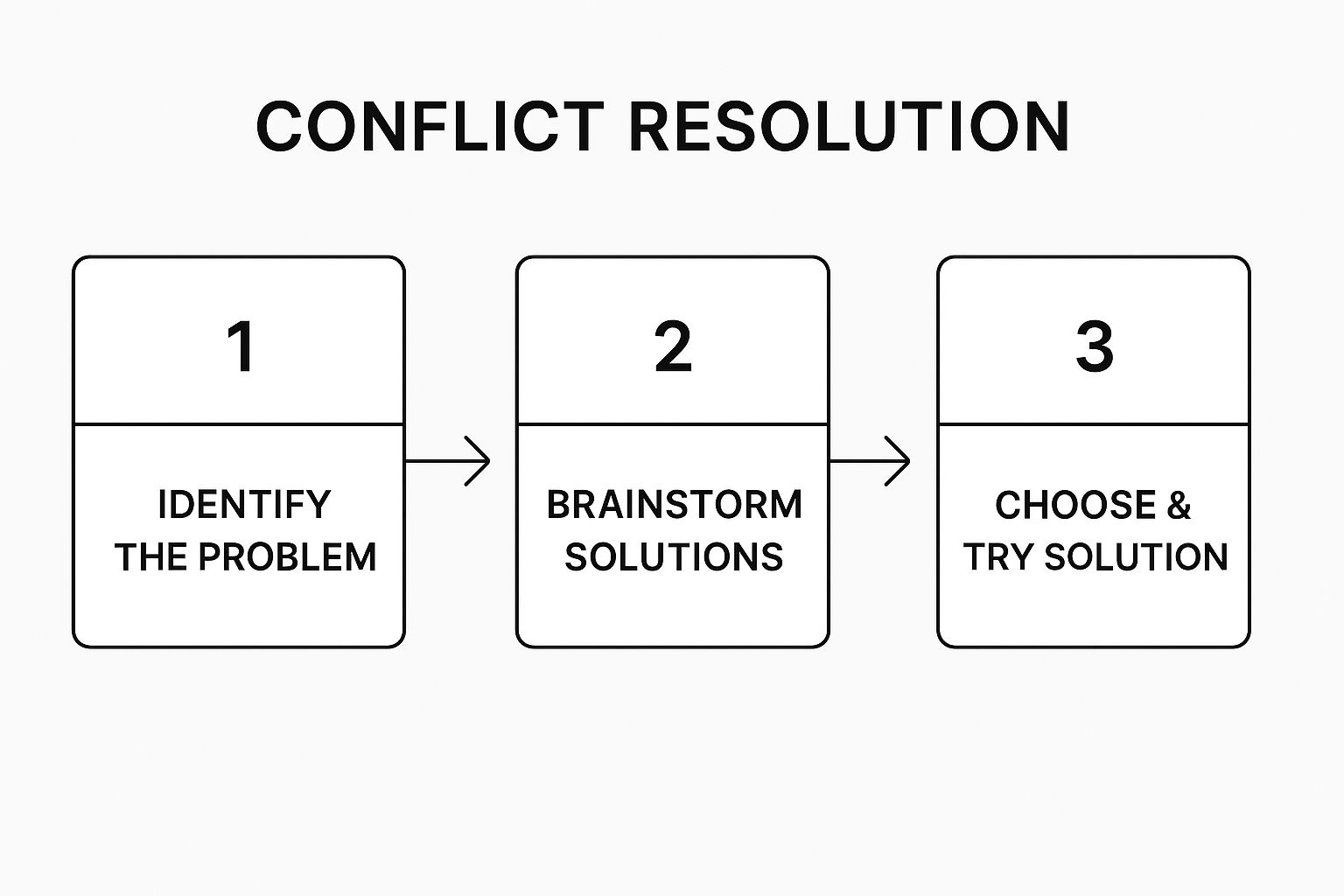
This structured flow helps children internalise a reliable method for tackling social problems calmly and effectively. Beyond general team challenges, specialised programmes such as those at the Elite Soccer Youth Development Academy can provide tailored instruction in social dynamics. You can learn more about specific conflict resolution techniques for kids to expand your toolkit.
Key Insight: The aim is not to eliminate conflict but to teach children that conflict is a normal part of life that can be managed productively. Providing them with a reliable problem-solving script empowers them with confidence and competence.
10. Show and Tell / Sharing Circle Activities
Sharing circles and show-and-tell are structured activities where children present something meaningful, like an object or an experience, to a group. This classic method provides a platform for children to practise public speaking, active listening, and showing genuine interest in their peers. It is one of the most foundational social skills activities for kids, building confidence and fostering a sense of community through shared stories and interests.
These activities, popular in early childhood education and adapted for older groups through concepts like 'Passion Projects', help children feel seen and valued. For example, a child might share a treasured family photo, a younger pupil might present a favourite toy, or an older student might discuss a new skill they are learning, like coding.
How to Implement Sharing Circles
- Provide Options: Allow children to bring an object, a photograph, or simply talk about something they find interesting. This inclusivity reduces pressure.
- Teach Active Listening: Before starting, model what good listening looks like: making eye contact, staying quiet, and thinking of relevant questions.
- Model Thoughtful Questions: After a child shares, show others how to ask open-ended questions like, "What was your favourite part about that?" or "How did you make that?"
- Keep it Equitable: Set a gentle time limit for each child to ensure everyone who wants to share gets a turn. An 'opt-out' or 'pass' option is crucial for children who may not feel ready.
Key Insight: The goal of a sharing circle is not the presentation itself, but the connection it creates. It teaches children that their voice matters and that listening to others is a powerful way to build friendships.
Top 10 Social Skills Activities Comparison
| Activity | Implementation Complexity 🔄 | Resource Requirements | Expected Outcomes 📊 | Ideal Use Cases 💡 | Key Advantages ⭐ |
|---|---|---|---|---|---|
| Role-Playing and Dramatic Play | Moderate 🔄 (Needs adult guidance and structure) | Minimal, low-cost materials, costumes recommended | Empathy, perspective-taking, communication | Teaching social scenarios, therapy, creative expression | Builds empathy; low-cost; adaptable |
| Cooperative Board Games and Team Challenges | Moderate 🔄 (Facilitation needed for participation) | Board games or team challenge setups | Collaboration, communication, teamwork | Social skills groups, classrooms, family therapy | Promotes teamwork; reduces competition |
| Emotion Charades and Feelings Identification Games | Low to Moderate 🔄 (Requires sensitive facilitation) | Emotion cards, mirrors, visual aids | Emotional literacy, self-awareness | Emotional intelligence development, therapy | Builds emotional intelligence; adaptable |
| Turn-Taking and Conversation Circle Activities | Low 🔄 (Structured with simple rules) | Talking sticks, balls, or visual cues | Listening skills, turn-taking, respect | Speech therapy, classrooms, restorative justice | Equal participation; builds listening |
| Social Stories and Comic Strip Conversations | Moderate to High 🔄 (Time-intensive customisation) | Paper, drawings, digital tools | Understanding social rules, reduced anxiety | Autism support, preparing for new situations | Clear expectations; highly visual |
| Collaborative Art and Building Projects | Moderate 🔄 (Needs materials and coordination) | Art supplies, building materials (LEGO, crafts) | Negotiation, cooperation, creativity | STEAM programmes, therapy, community projects | Hands-on; less verbal demand; creative |
| Peer Buddy Systems and Structured Play Dates | Moderate 🔄 (Requires adult coordination) | Minimal; depends on activity chosen | Skill practice, confidence, friendship | Social skills practice, therapy, buddy programmes | One-on-one focus; builds confidence |
| Group Sports and Physical Team Activities | Moderate to High 🔄 (Requires space, rules enforcement) | Sports equipment, safe play area | Teamwork, leadership, resilience | Physical education, inclusive sports, therapy | Combines physical/social skills; engaging |
| Problem-Solving and Conflict Resolution Scenarios | Moderate 🔄 (Needs consistent reinforcement) | Scenario cards, visuals, possibly props | Critical thinking, negotiation, empathy | SEL curricula, peer mediation training | Teaches independence and perspective-taking |
| Show and Tell / Sharing Circle Activities | Low 🔄 (Simple structure, time-managed) | None to minimal | Confidence, communication, social connection | Early education, social skills groups | Builds public speaking; encourages sharing |
Building a Toolkit for Lifelong Emotional Health
Integrating the social skills activities for kids outlined in this guide into a child's routine is more than just a fun way to pass the time; it is a foundational investment in their future wellbeing. From the collaborative problem-solving in team challenges to the empathy developed through role-playing and social stories, each activity serves as a building block for emotional intelligence. These aren't just games, but practical, hands-on lessons in communication, cooperation, and conflict resolution that equip children to navigate the complexities of human relationships.
The true power of these exercises lies in their consistency and application to real-world scenarios. The skills practised during a game of Emotion Charades or a cooperative board game become the internal tools a child can draw upon when facing a disagreement on the playground or feeling misunderstood by a friend. By actively engaging in these structured interactions, children learn to recognise and manage their own feelings while also developing a crucial awareness and respect for the emotions of others. This consistent practice helps to normalise conversations around mental and emotional health from an early age, a vital step in a world where social pressures, particularly from social media, are increasingly prevalent.
Actionable Next Steps for Parents and Educators
To continue building on this momentum, consider these practical steps to embed social-emotional learning into daily life:
- Create a 'Feelings Corner': Designate a quiet space in your home or classroom with calming tools like cushions, colouring sheets, and books about emotions. This gives children a safe place to process their feelings. Some simple relaxation tips include practising slow, deep 'belly breaths' or gently squeezing a stress ball.
- Model Healthy Emotional Expression: Children learn by observing. Talk openly about your own feelings in an age-appropriate way, for instance, saying, "I'm feeling a bit frustrated that the traffic is so slow, so I'm going to take a few deep breaths to help me calm down."
- Use Everyday Moments as Teachable Opportunities: When watching a film or reading a story, pause and ask questions like, "How do you think that character is feeling right now? What makes you think that?" This reinforces the skill of perspective-taking. Wearing mental health apparel, like a t-shirt with a positive message, can also be a gentle conversation starter.
Beyond specific social activities, another vital 'tool' for lifelong emotional health involves learning how to foster building mental toughness and resilience. This involves teaching children how to bounce back from setbacks and view challenges as opportunities for growth, which complements the social skills they are developing. Remember, while these activities are incredibly beneficial, it is important to acknowledge that I am not a mental health professional. If you have serious concerns about your child's emotional wellbeing or social development, seeking guidance from your GP or a qualified child therapist is a sign of proactive and responsible care. Your intuition as a parent or educator is powerful, and acting on it is always the right choice.
Ready to take the next step in nurturing your child's emotional literacy? Explore the beautifully illustrated books and resources from Little Fish Books. Our stories are designed to make complex feelings understandable and accessible, providing the perfect starting point for meaningful conversations that build strong social and emotional foundations. Discover your next favourite story at Little Fish Books today.
